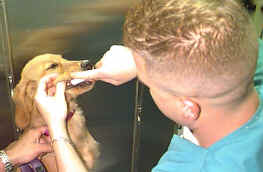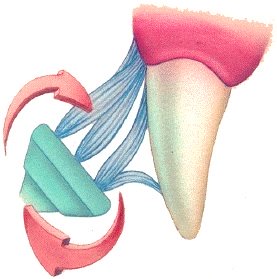Table of Contents
Summary:
"Brushing dog teeth is just as important as brushing human teeth. Use this guide to learn how help your dog get comfortable with making brushing teeth a part of his or her daily routine."
Overview
Regular dental care is important for your dog. It prevents tooth decay, just like it does for people. Brushing dog teeth is an important part of good dental care. Ideally you should brush dog teeth every day, but if that's not possible, do it several times a week.

Source: Dentalvet
Canine Teeth Health
When you take your dog to the vet for his annual check-up, your vet will check your dog's teeth. If there is significant plaque build-up, he may need a professional cleaning, which is usually done under anesthesia. Regular brushing can prevent the build-up of plaque.
Guide to Brushing Dog Teeth
Follow these steps for brushing your dog's teeth:
- Have your dog get used to you putting things in his mouth by
starting slowly. Dig your finger in something tasty, like beef bullion.
Put your finger in your dog's mouth and move it in a circular motion
over his teeth and gums. Focus on the gum line (the crevice where the
gums meet the teeth), where bacteria and food mix to form plaque. Start
at the front of the mouth, then move to the back upper and lower teeth
and gum areas. Do this several times a week, and after a few sessions
your dog will be comfortable with having your finger in his mouth.
- Now place a gauze pad around your finger and repeat the procedure.
You can dip the pad in the beef bullion so your dog enjoys the taste.
After a few sessions, your dog will be comfortable with this procedure.
- Next, let your dog get used to the toothbrush you are going to use.
Finger toothbrushes are the easiest to use. Finger toothbrushes do not
have a handle but fit over your finger (they look sort of like a
thimble) such as the Four Paws Pet Dental Finger Toothbrush and Toothpaste.
Let your dog lick something tasty off the brush so he gets used to it.
You can also try a ultra soft toothbrush made for humans, although one
designed for dogs is preferred.
- Now let your dog get used to the toothpaste. Use a pet toothpaste,
not a human toothpaste. People toothpaste will upset your dog's stomach
and your dog will not like the flavor. Pet toothpaste comes in flavors
like poultry and malt and your dog will like the taste. Let your dog
lick some off your finger and then off the toothbrush.
- Now that your dog is used to having your fingers in his mouth and is used to the toothbrush and toothpaste, you are ready to begin brushing his teeth. The bristles should be held at a 45-degree angle to the tooth surface and be moved in an oval motion. Scrub in the gum line, as this is where odor and infection begin. Start with just a few teeth at a time. The upper canines (the large ones at the front of the mouth) are good ones to start with. Over time you can begin brushing more and more teeth until you can brush them all. Give your dog lots of praise. You can also give him a treat after brushing his teeth to reward him.

Brushing your dog's teeth should only take 1 to 2 minutes. If you dog doesn't cooperate try gently wrapping him in a large bath towel with his head sticking out. Always be gentle and praise your dog.
Diet and Dog Teeth
To keep your dog's teeth healthy you can feed a dental-formulated diet consisting of dry dog foot, and give your dog dental chews to prevent plaque from building above the gum line. You can can also apply OraVet Treatment to help prevent plaque and tartar buildup above and below the gum line. This product is becoming the standard to help dog's with plaque problems.
Natural Support for Canine Teeth
Many owners also like to also add a natural supplement to their dog's diet such as Pet Alive Gums-n-Teeth. It is formulated to help prevent dog gingivitis and promote the overall health of canine teeth and gums. These products contain natural ingredients known to support dental health such as Spirulina (Human studies have shown Spirulina to promote oral health in particular (Mathew, B., Sankaranarayanan, R., Nair, P. P., Varghese, C., Somanathan, T., Amma, B. P., Amma, N. S., and Nair, M. K. Evaluation of chemoprevention of oral cancer with Spirulina fusiformis. Nutr Cancer 1995; 24(2):197-202) and horsetail (has a high silica content, which is essential in the maintenance of healthy and strong teeth.
Sources
Brushing Teeth and Home Dental Care
Nash, Holly DVM
